Montalcino: what to see, where to eat and sleep in the city of Brunello
Everything you need to know about the world's most famous Tuscan wine village
We are in the home of Brunello, the most famous Tuscan wine in the world. From the heights of Montalcino you can see the entire Val d'Orcia. We are perched on a hill south of Siena, at the foot of which the abbey of Sant'Antimo stands out in a timeless setting, while famous vineyards surround its flanks. Compared to other Italian wine areas, this is a handkerchief. That is why it is even more prized and coveted.
The origins of Montalcino date back to the Carolingian period (7-800 AD). Due to its strategic position, on a hill 560 metres above sea level, during the communal period, the town was the object of frequent attacks by nearby Siena, in perennial dispute with Florence. After the historic Battle of Montaperti in 1260, Florence ceded Montalcino to Siena. Arts and crafts flourished in the town and around the 15th century the town took on its current urban organisation.
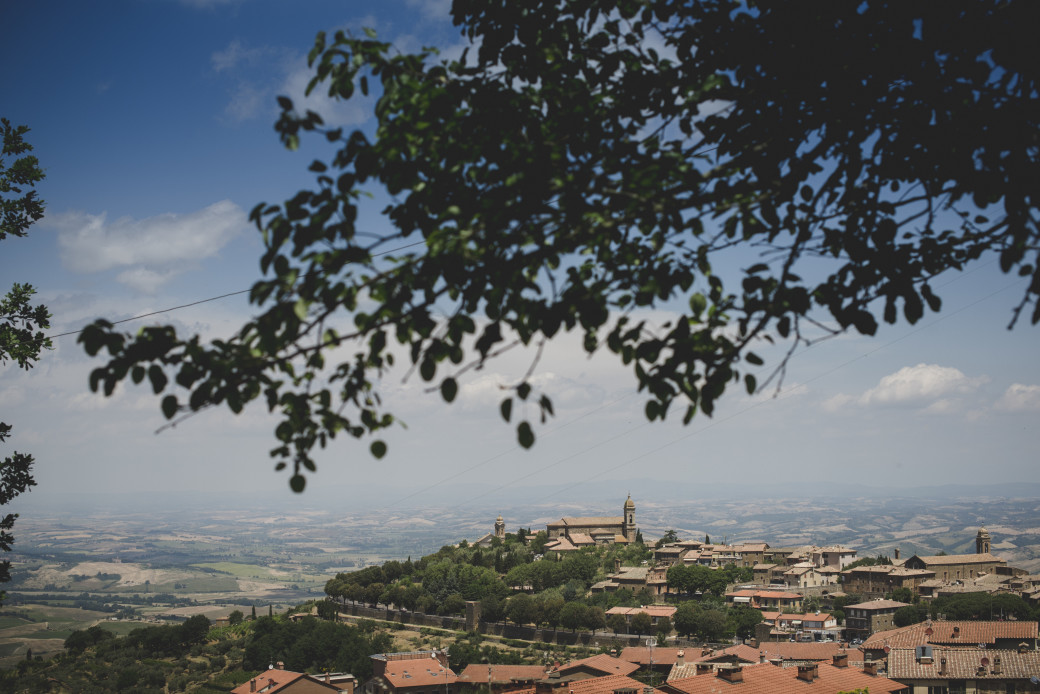 Montalcino ph. Pasquale Paradiso
Montalcino ph. Pasquale ParadisoWHAT TO SEE IN MONTALCINO:
La Fortezza di Montalcino
It was built from 1361 onwards, partly reusing the pre-existing 13th-century city walls. Its structure, pentagonal in shape, was a novelty at the time compared to the classical square structure. Some earlier buildings were incorporated into the fortress, such as the tower of San Giovanni, the keep of San Martino and an ancient three-nave basilica. The walls and towers, equipped with an external patrol walkway, are still fully passable today.
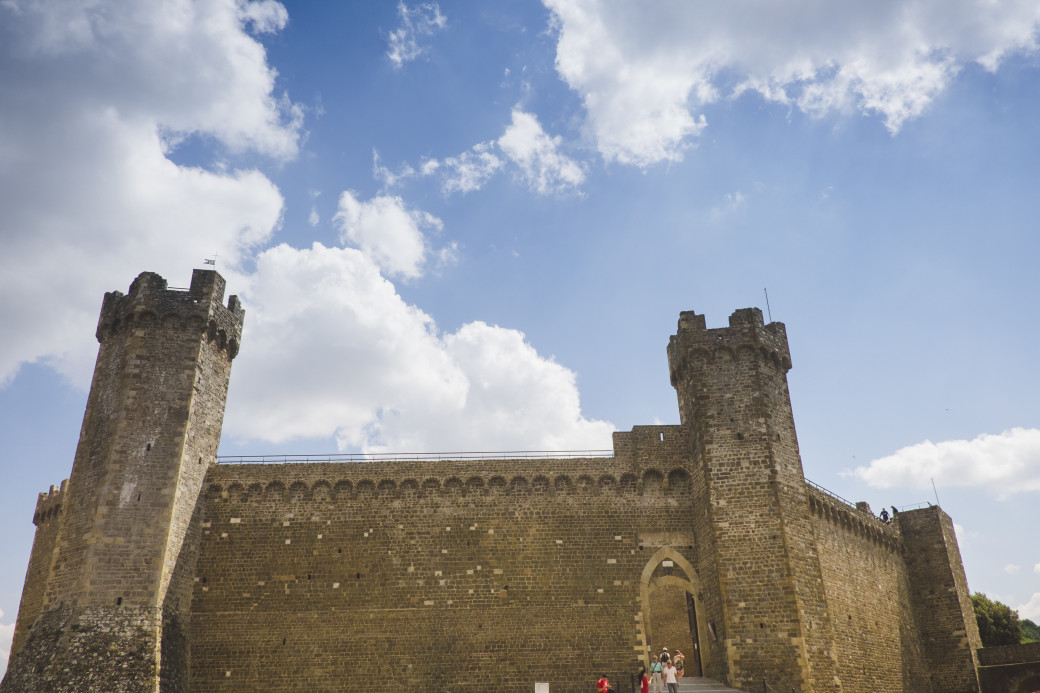 Fortezza di Montalcino ph Pasquale Paradiso
Fortezza di Montalcino ph Pasquale ParadisoPalazzo dei Priori
The main building in the square is the town hall, known as the Palazzo dei Priori. It is adorned with the heraldic coats of arms of the numerous podestà who have governed the city over the centuries. A very tall medieval tower is incorporated into the palace. Next to the municipal palace, there is a Renaissance structure with six round arches, called La Loggia, which was started at the end of the 14th century and finished in the early 15th century, but has undergone numerous restorations over the following centuries.
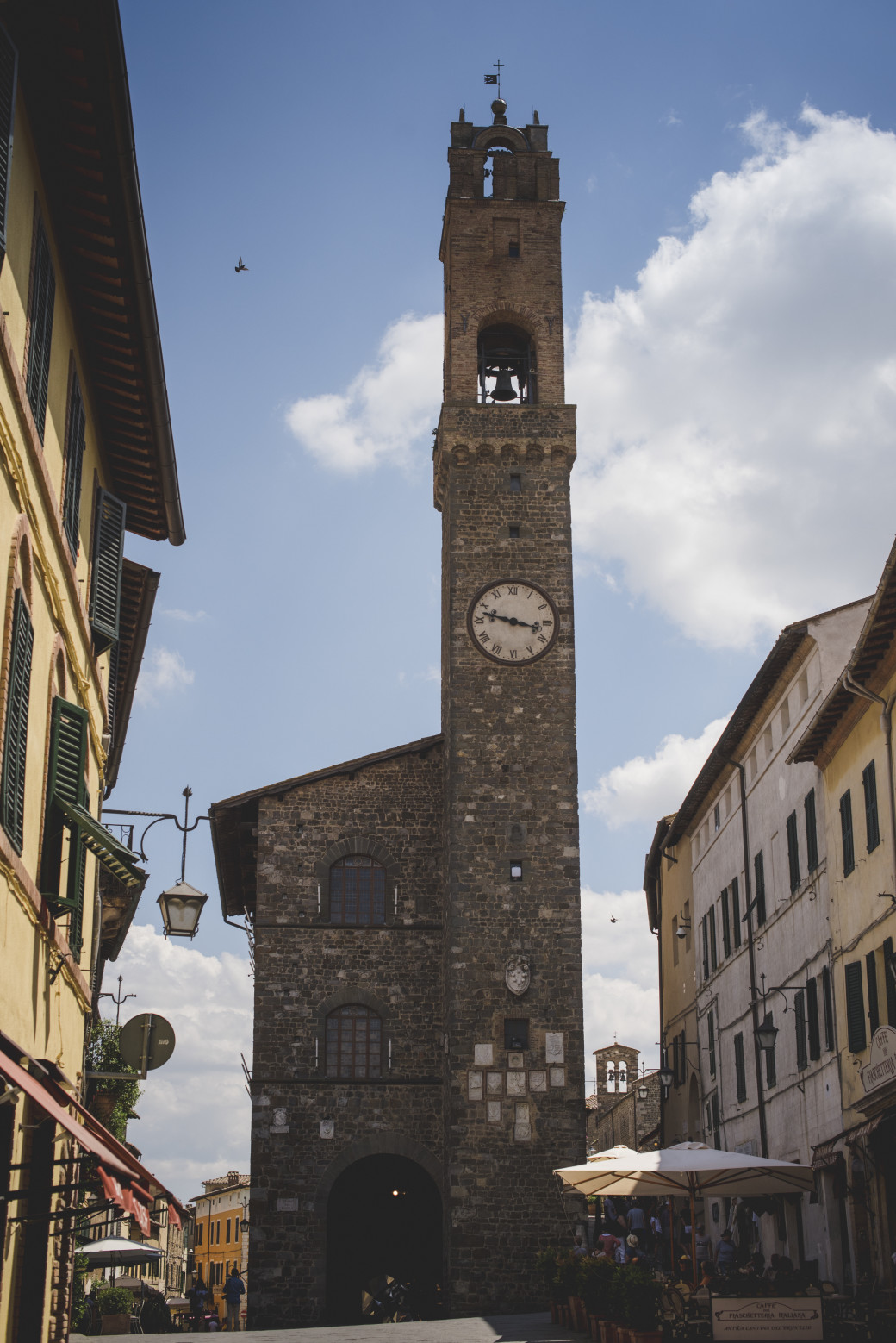 Palazzo dei Priori ph Pasquale Paradiso
Palazzo dei Priori ph Pasquale ParadisoIl Duomo
Named after the Holy Saviour, the Cathedral is the city's main religious building. The ancient church was built around 1400 and, after demolition, was completely rebuilt in the Neoclassical style. The cathedral is divided into three naves, where numerous works can be found, such as the altarpiece Immaculate Conception with Jesus and God the Father, by Francesco Vanni.
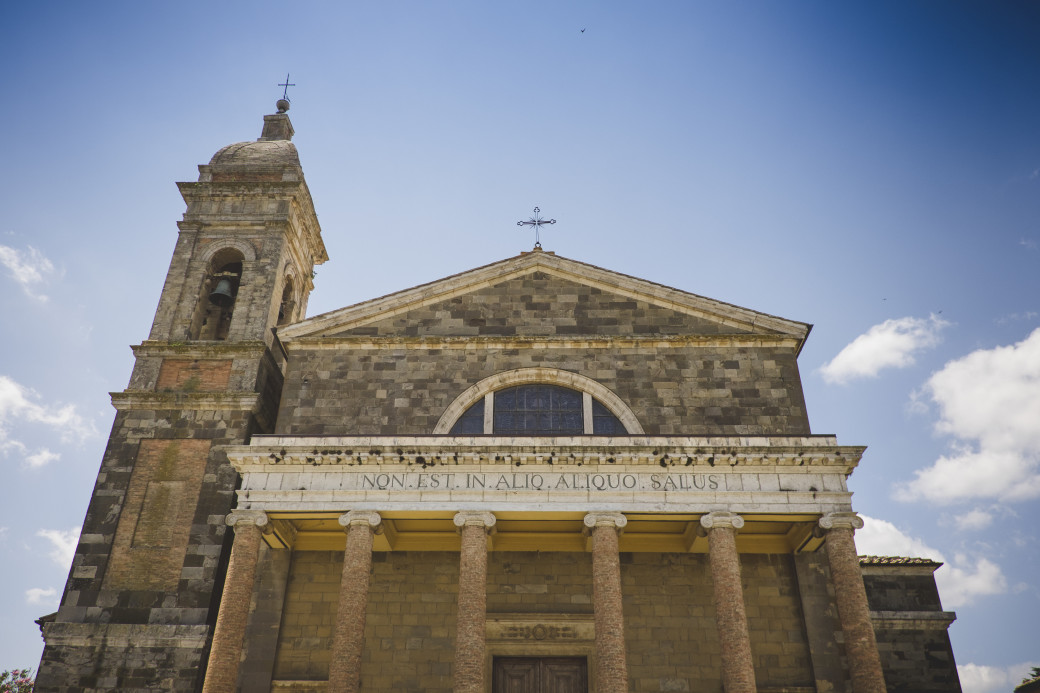 Montalcino Cathedral
Montalcino CathedralLa Chiesa della Madonna del Soccorso
This was the result of a battle that took place in 1553, when the people of Montalcino emerged victorious after a long siege by the Spanish army led by Don Garcia de Toledo. The sanctuary, dating back to the 12th century, had been built on the site of the small medieval church of Porta al Corniolo: inside, an ancient panel depicting the Virgin and Child, next to Saints Peter and Paul, would have been placed.
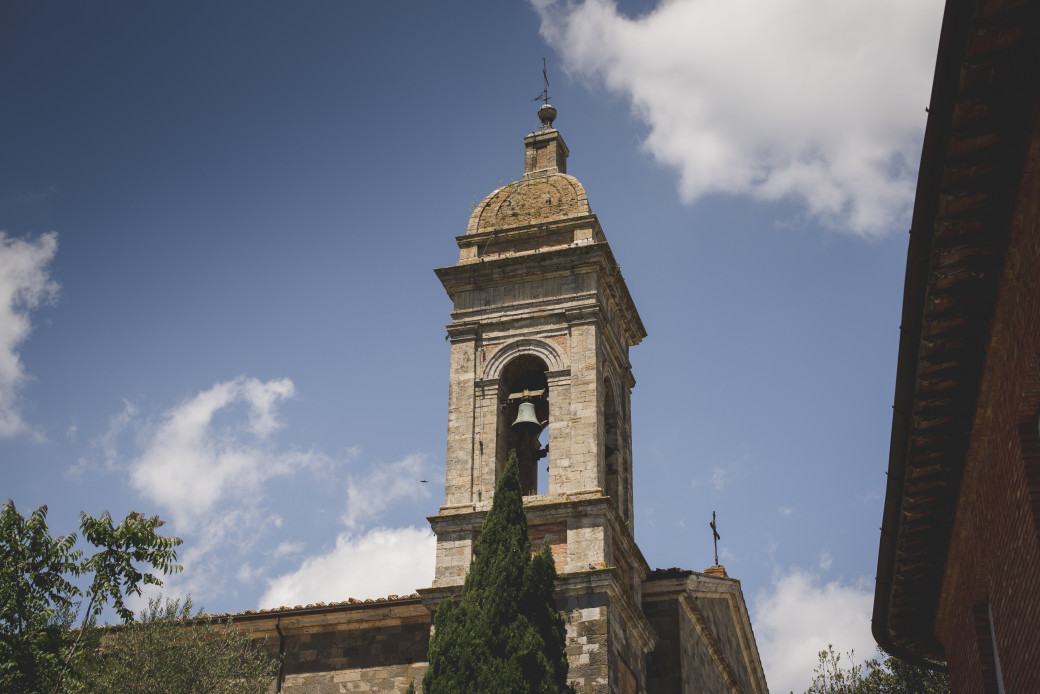 Chiesa della Madonna del Soccorso
Chiesa della Madonna del SoccorsoLa Chiesa di Sant’Agostino
Erected between the 13th and 14th centuries, it features the characteristics of Gothic architecture in its cusped portal and pinnacles; inside, it is decorated with precious frescoes mostly related to the activity of the Sienese painter Bartolo di Fredi. If on the perimeter walls of the naves one can recognise the main saints and blessed of Augustinian devotion, in the apse one can distinguish detailed episodes from the life of Saint Augustine.
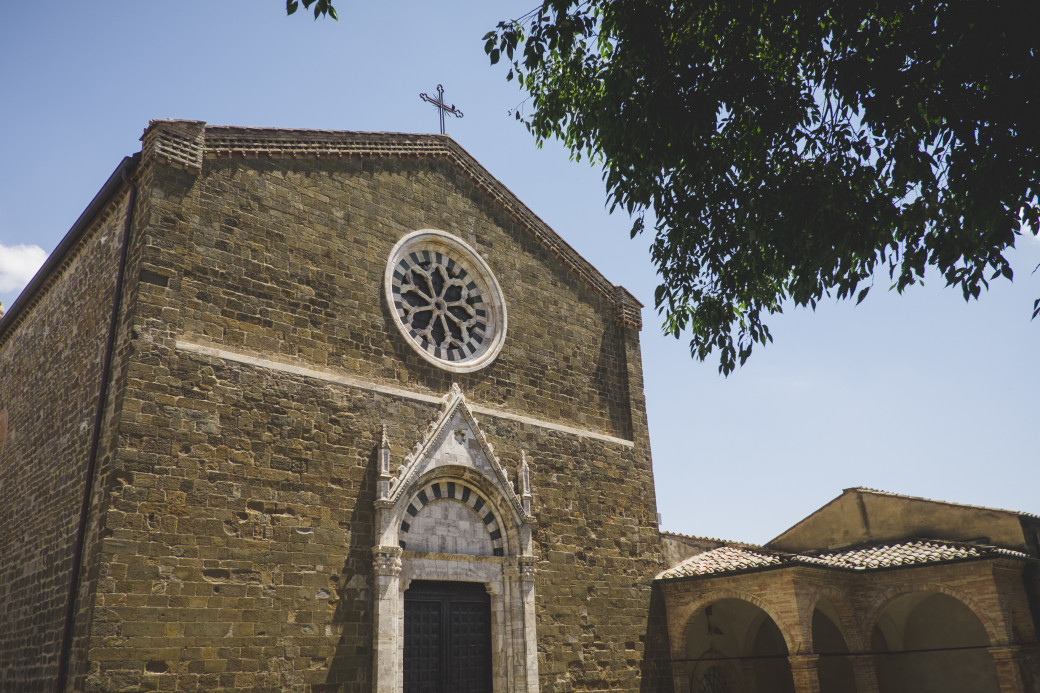 Chiesa di Sant'Agostino ph Pasquale Paradiso
Chiesa di Sant'Agostino ph Pasquale ParadisoMuseo Civico e Diocesano d'Arte Sacra
It is housed in part of the former 15th-century convent of Sant'Agostino, including one of the two cloisters and the Chapter House. The collection allows visitors to discover the local artistic production from the Middle Ages to the historical 20th century, with particular emphasis on the Sienese painting tradition, represented by masters such as Bartolo di Fredi, Simone Martini, Ambrogio Lorenzetti, Giovanni di Paolo and Sano di Pietro, and finally by a local painter and photographer, Arturo Luciani.
WHAT TO SEE AROUND MONTALCINO:
Abbazia di Sant'Antimo
Founded, according to tradition, by Emperor Charlemagne in 781, an authentic Romanesque masterpiece. A true white mirage amidst the vineyards. The walls of Sant'Antimo are not only a marvellous monument, but become the custodians and witnesses of Benedictine monastic spirituality.
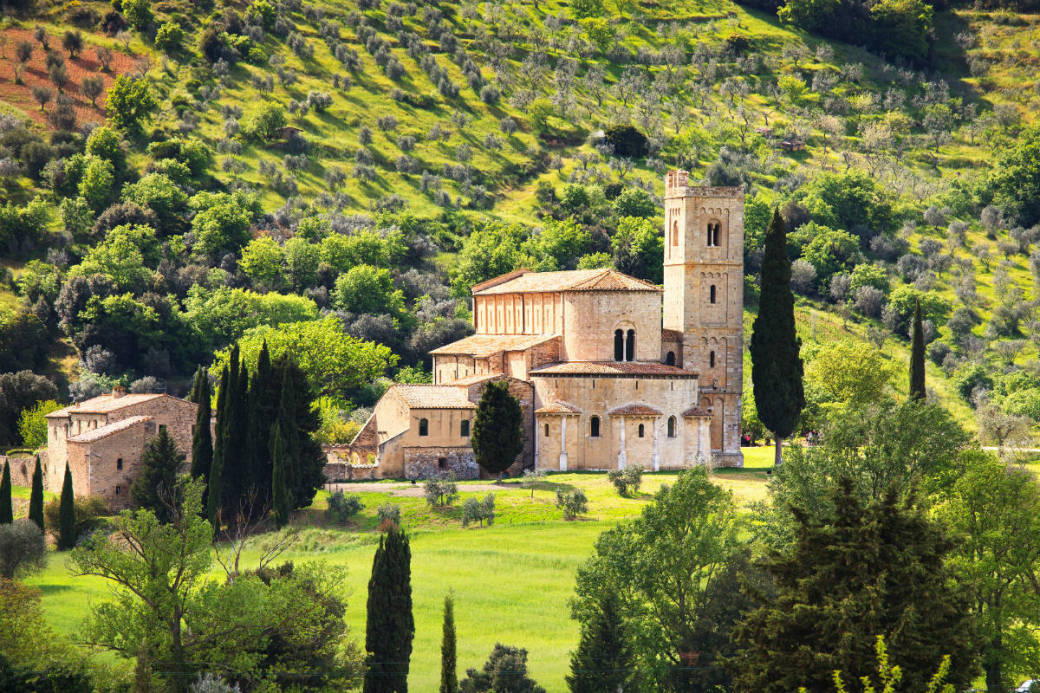 Sant'Antimo abbey
Sant'Antimo abbeyCastello di Poggio alle Mura
The complex developed mostly between the 9th and 13th centuries, but its origin is certainly earlier. Some dungeons dug into the tuff and still visible today, as well as some stone urns and ceramic vases found during the last restoration, suggest, in fact, the existence of a settlement already in Etruscan times. The 'ashlars' - white stones typically used in the construction of Roman arches - inserted in the entrance arch seem, instead, to testify to a later transformation into a Roman villa.
Pienza
There is no better definition of Pienza than the words dedicated to it by Pascoli: 'born from a thought of love and a dream of beauty'. Here are all our tips on where to eat and what to do in the town commissioned by Pius II.
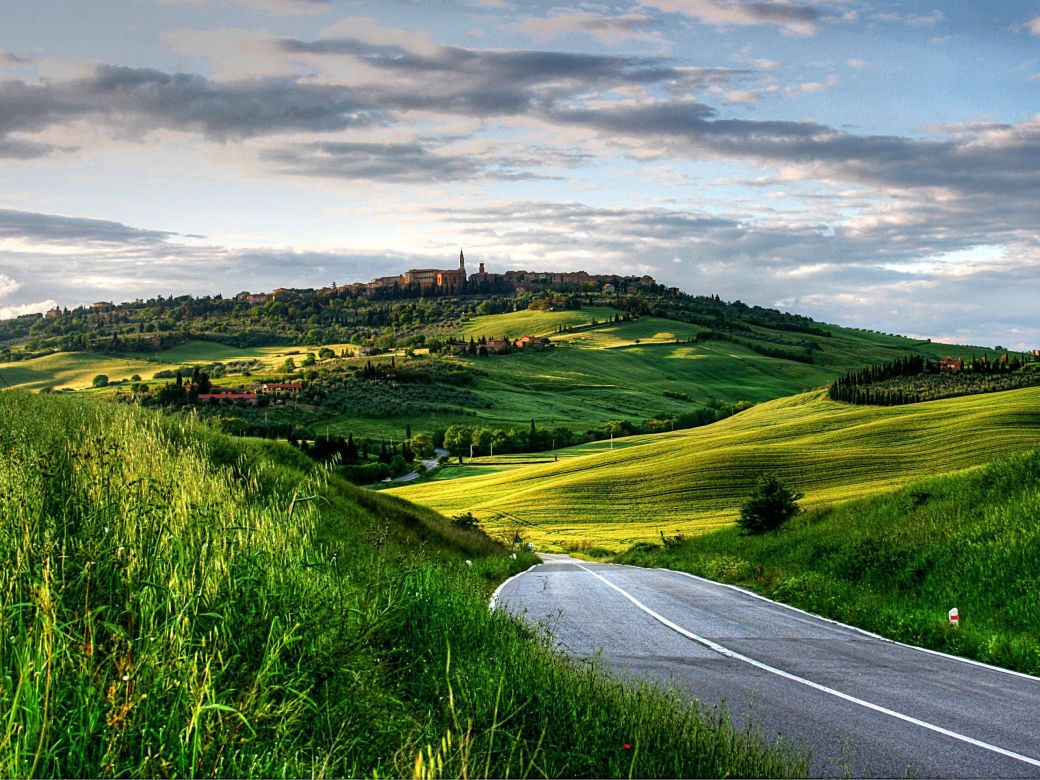 Pienza
PienzaBagno Vignoni
The historic centre is unique: instead of a square, there is a large pool of thermal water where St Catherine of Siena used to go for treatment in the 14th century and where Tarkovsky shot the most evocative scenes of the film Nostàlghia.
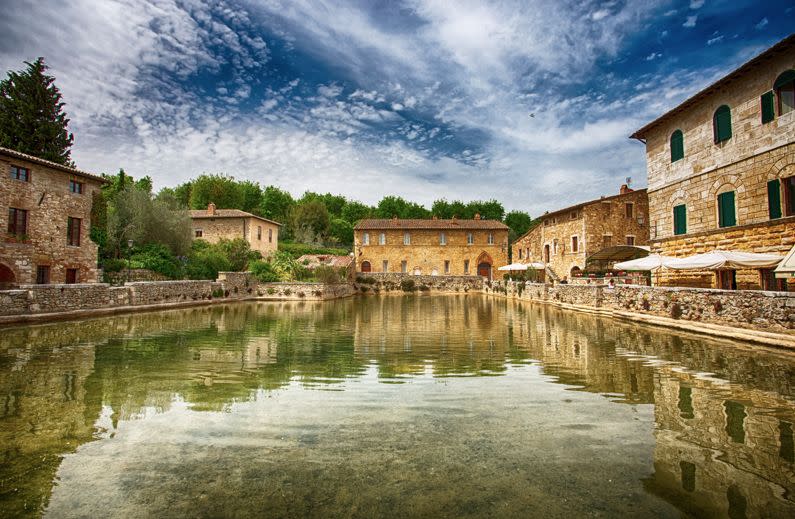 bagno vignoni
bagno vignoniSan Quirico d'Orcia
Above the remains of the ancient village of Osanna stands the village that has defined the archetype of the Tuscan landscape: its cypresses are the most photographed in the world.
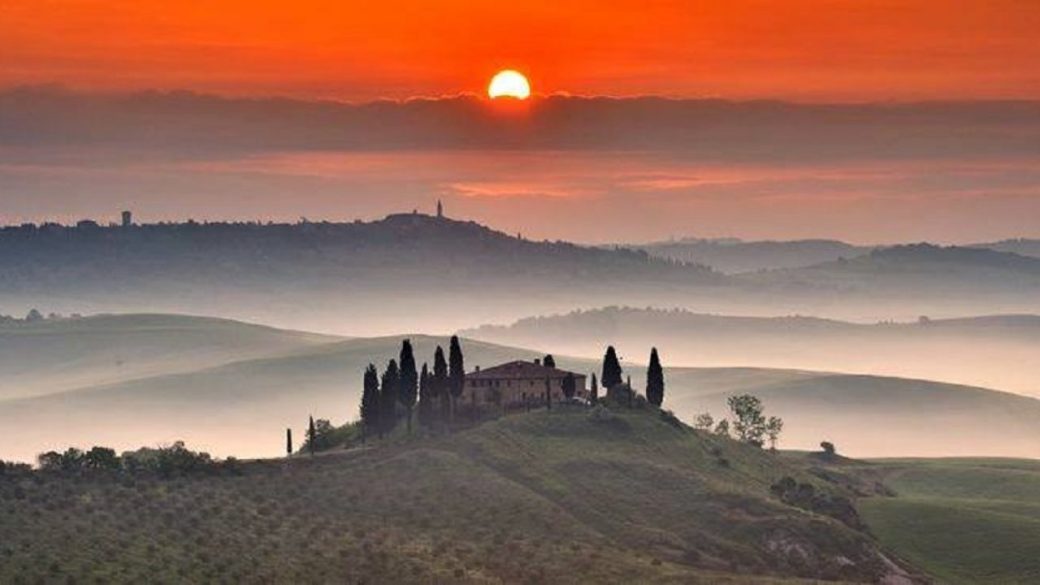 Profile of San Quirico d'Orcia among the hills
Profile of San Quirico d'Orcia among the hillsAbbazia di San Galgano
A Gothic-style mirage that appears out of the blue among the curving country roads, with the mystical charm of the union of heaven and earth due to the absence of a roof.
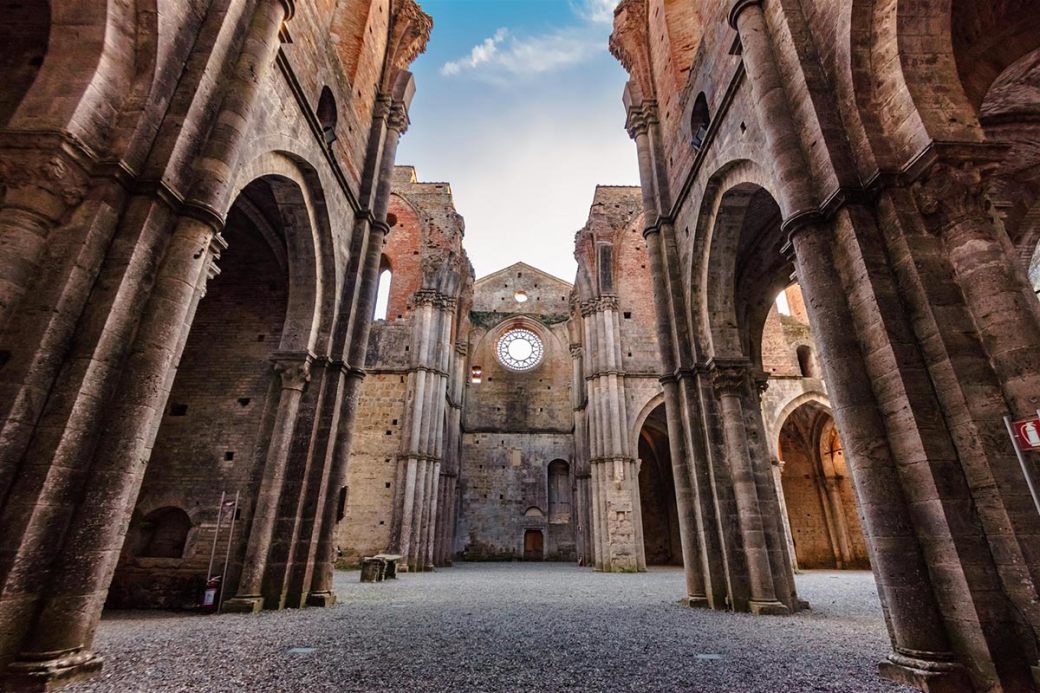 abbazia di san galgano
abbazia di san galganoMonticchiello
A typical medieval village in the Sienese countryside famous for the historical tradition of the Teatro Povero (Poor Theatre) in which all the inhabitants are authors and actors.
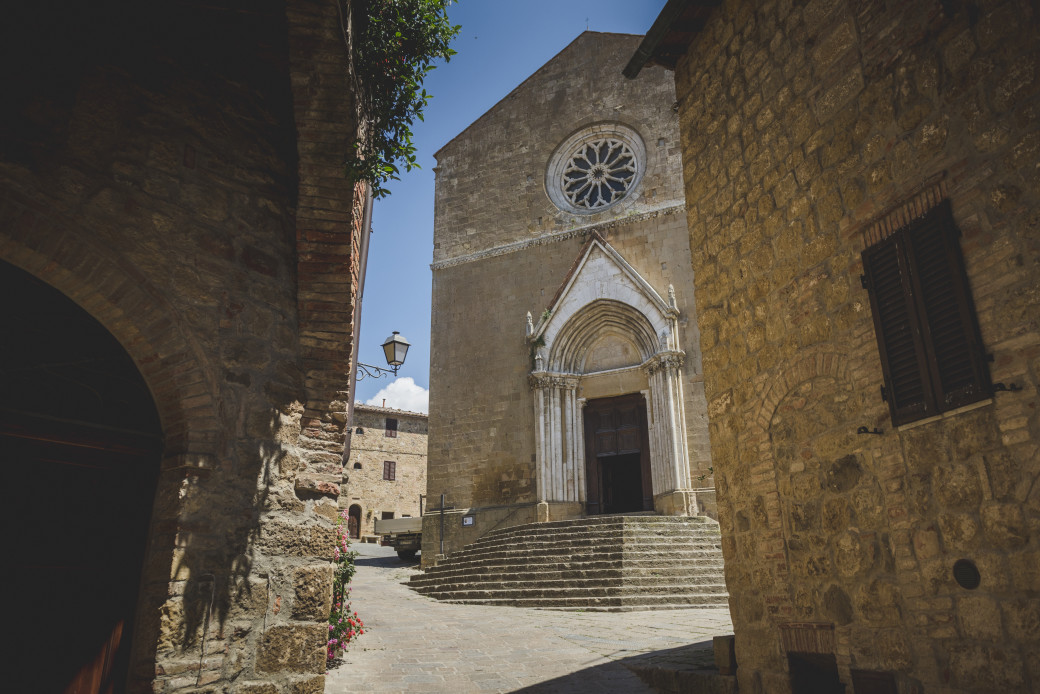 Monticchiello ph Pasquale Paradiso
Monticchiello ph Pasquale ParadisoWHERE TO EAT IN MONTALCINO:
Before discovering the best restaurants in Montalcino, click here if you want to know our selection of restaurants around Florence, here for our selection of the most beautiful wine cellars where to eat in Tuscany and here the best wine cellars to visit in Montalcino.
Albergo Ristorante Il Giglio
Via Soccorso Saloni, 5
ph. +39 0577 848167
This restaurant in the heart of the village - in a small, family-run hotel - has over 120 years of history. Tuscan cuisine (lightened), encyclopaedic wine list and fair prices.
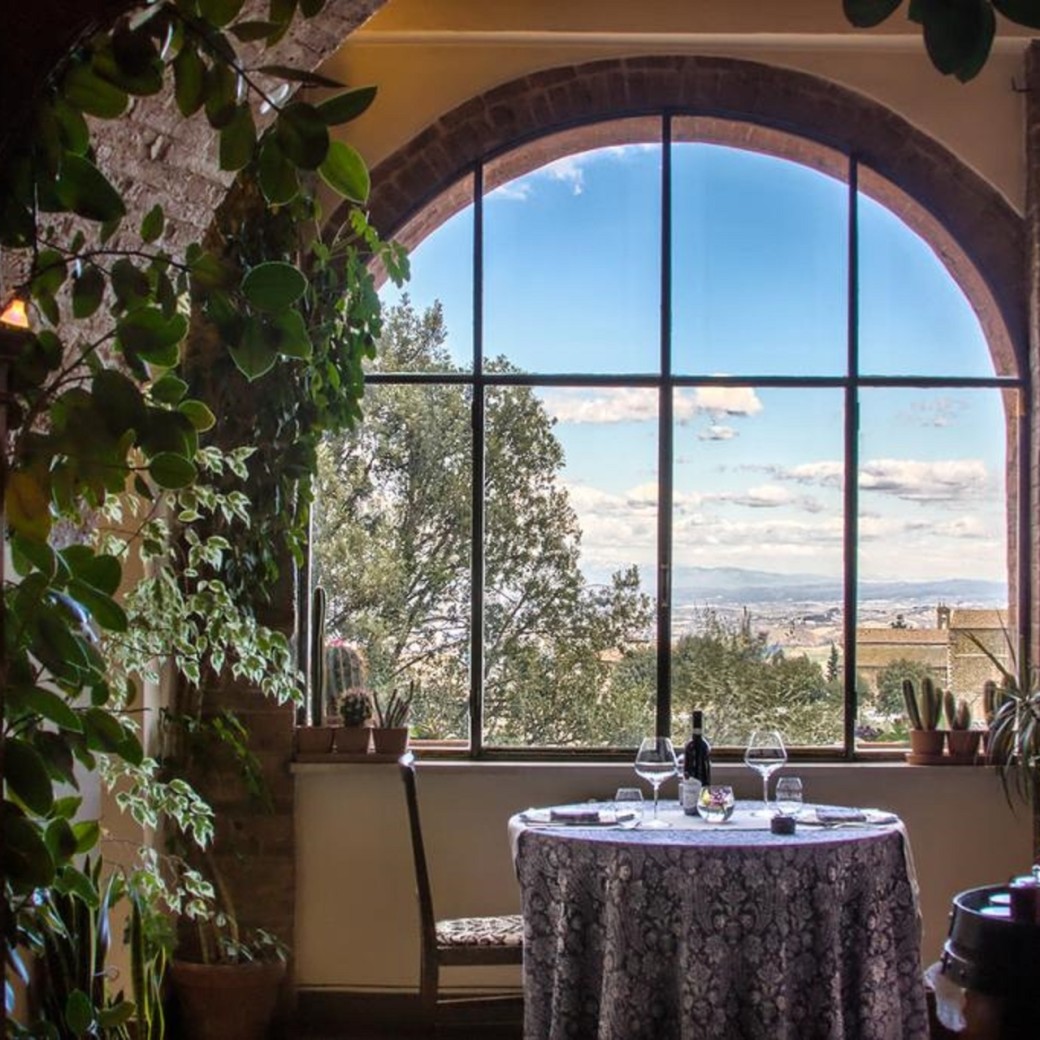 il giglio
il giglioEnoteca Osteria Osticcio
Via Giacomo Matteotti, 23
ph. +39 0577 1393288
Traditional and refined cuisine. Fabulous wine cellar. Three dishes not to be missed: the anchovies sottopesto, the spinach carbonara, the sausage with Casentino pan-fried egg with potato and bacon pie. In the room at the back there is a giant window with a breathtaking view. A must!
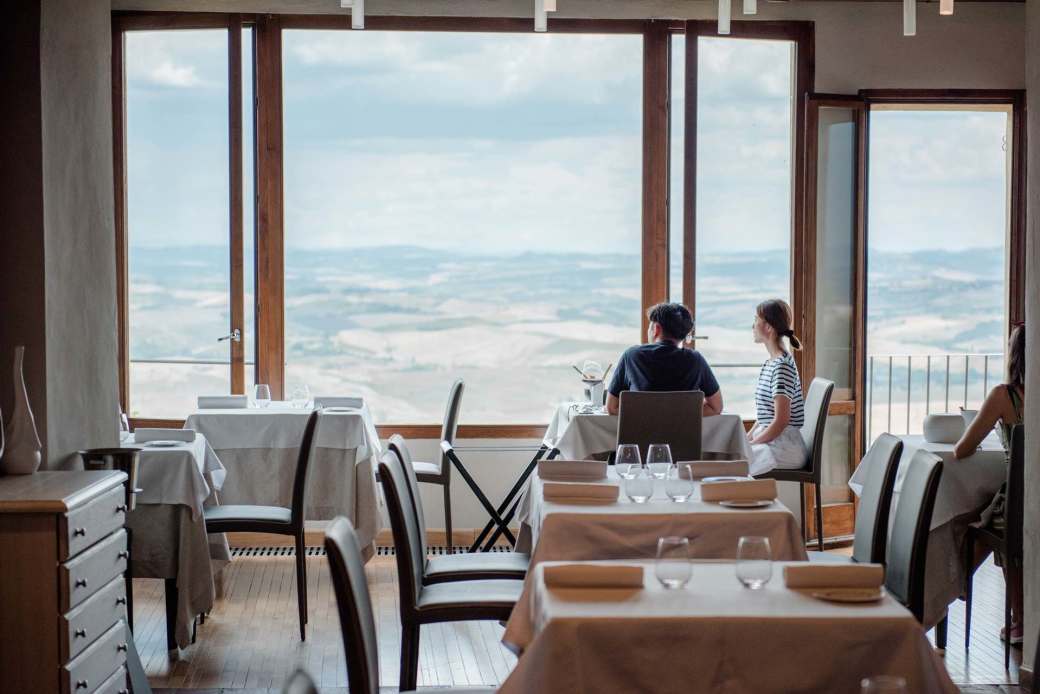 Osticcio
OsticcioTaverna del Grappolo Blu
Scale di Via Moglio, 1
ph. +39 0577 847150
Informal atmosphere and rustic tone, very enjoyable: from crostini and typical cold cuts to tagliolini with truffle cream and mushrooms, from pici all'aglione to beef cheek with Brunello.
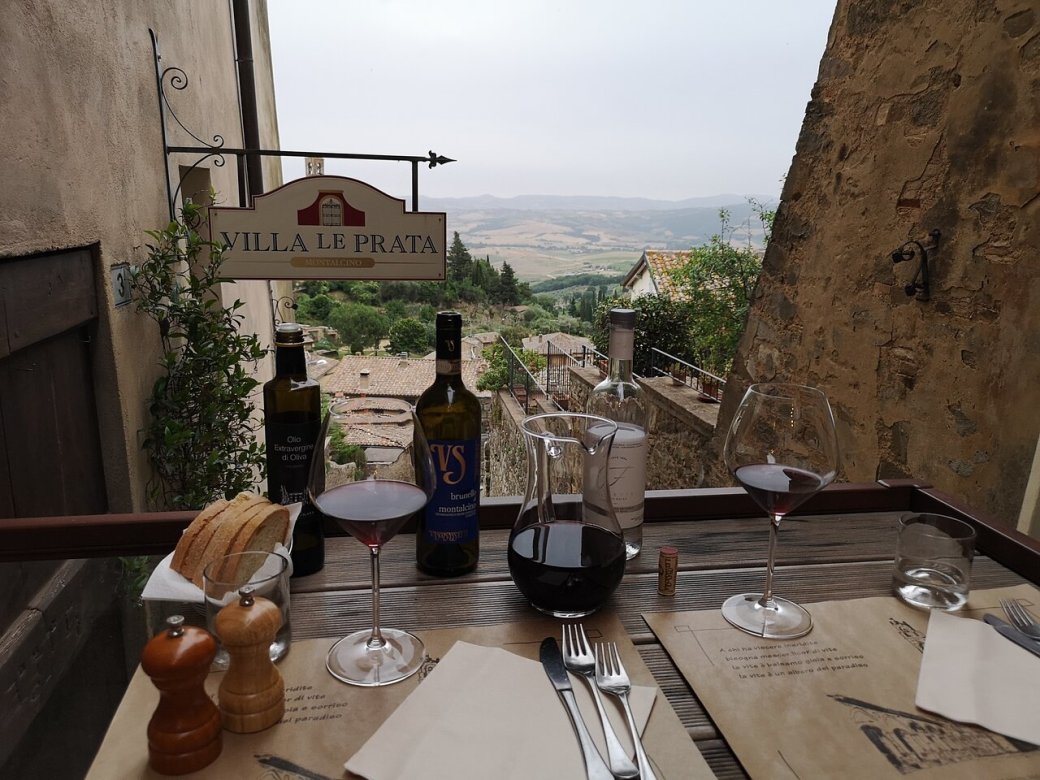 Taverna del Grappolo Blu
Taverna del Grappolo BluOsteria di Porta al Cassero
Via Ricasoli, 32 e Viale della Libertà, 9
ph. +39 0577 847196
Where there used to be old stables, stands this restaurant with a regulation bar and stylish furnishings. The mixed starter with bruschetta is a must, and the house wine is not bad.
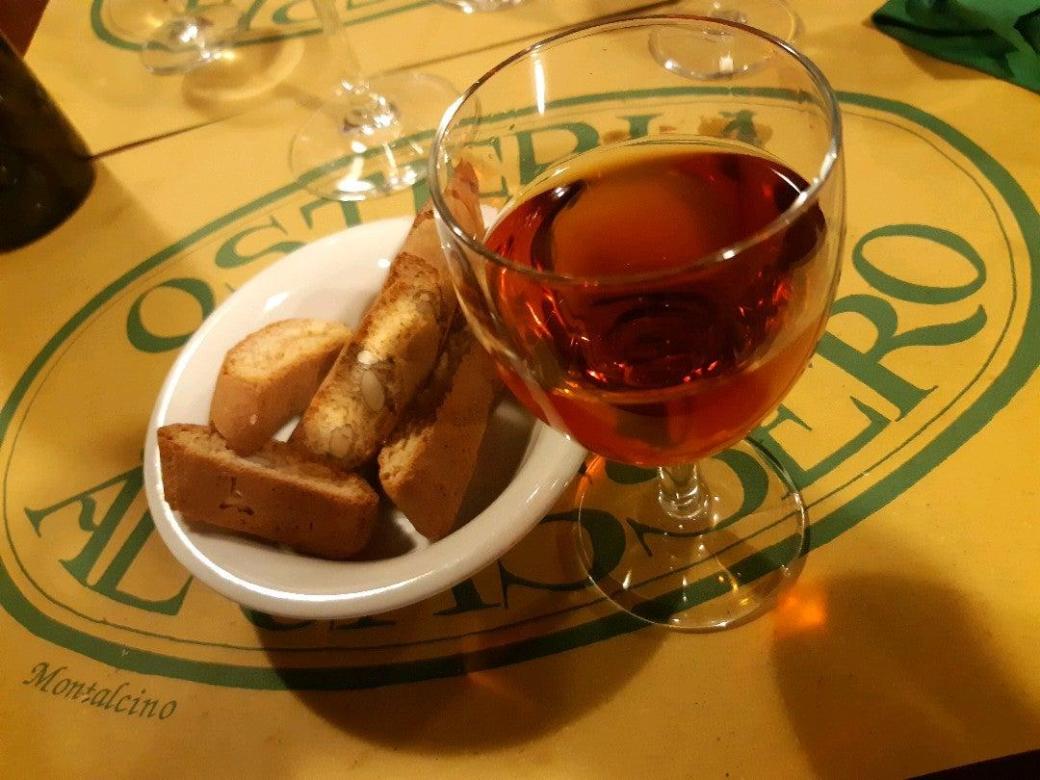 Osteria di Porta al Cassero
Osteria di Porta al CasseroDrogheria e Locanda Franci
Piazzale Fortezza, 5
ph. +39 0577 848191
Cellar that goes all the way into the basement with a spiral staircase, carefully prepared cuisine where even nouvelle cuisine dishes are not served in nouvelle cuisine quantities: try the octopus on chickpea cream, lasagna with porcini mushrooms and pigeon.
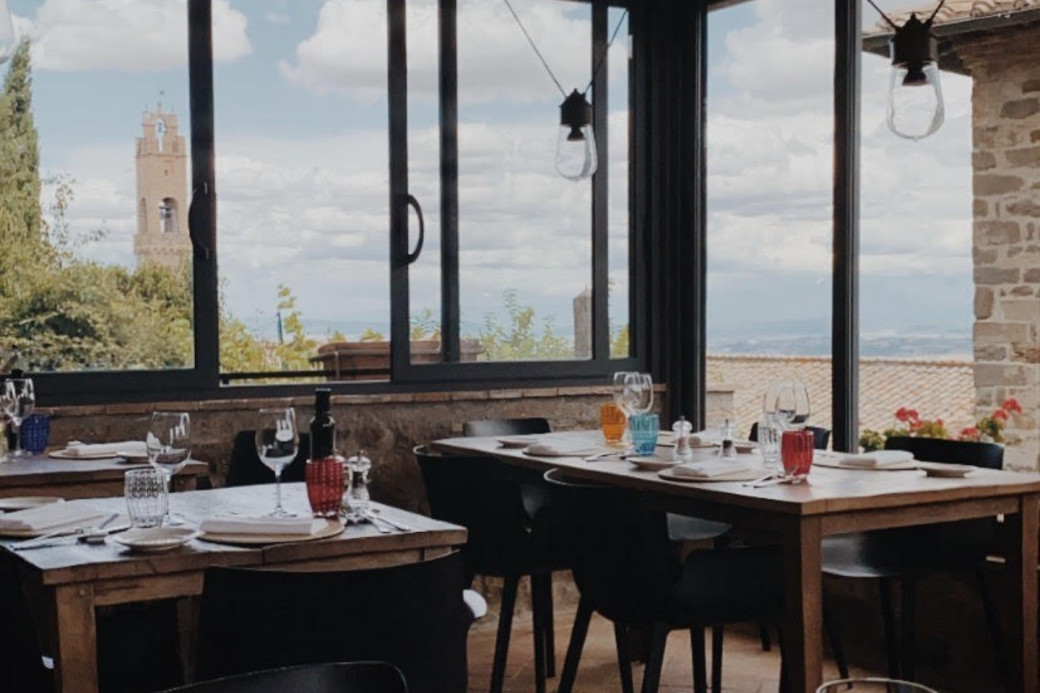 Drogheria Franci
Drogheria FranciVineria Le Potazzine
Piazza Giuseppe Garibaldi, 9
ph. +39 0577 846054
Open from late morning until sundown, like French brasseries. Aperitifs and snacks with taglieri and crostini to accompany a glass from the always interesting and well-stocked taproom. At lunch try pappa al pomodoro and peposo. In summer, eat al fresco in the piazza Garibaldi lounge.
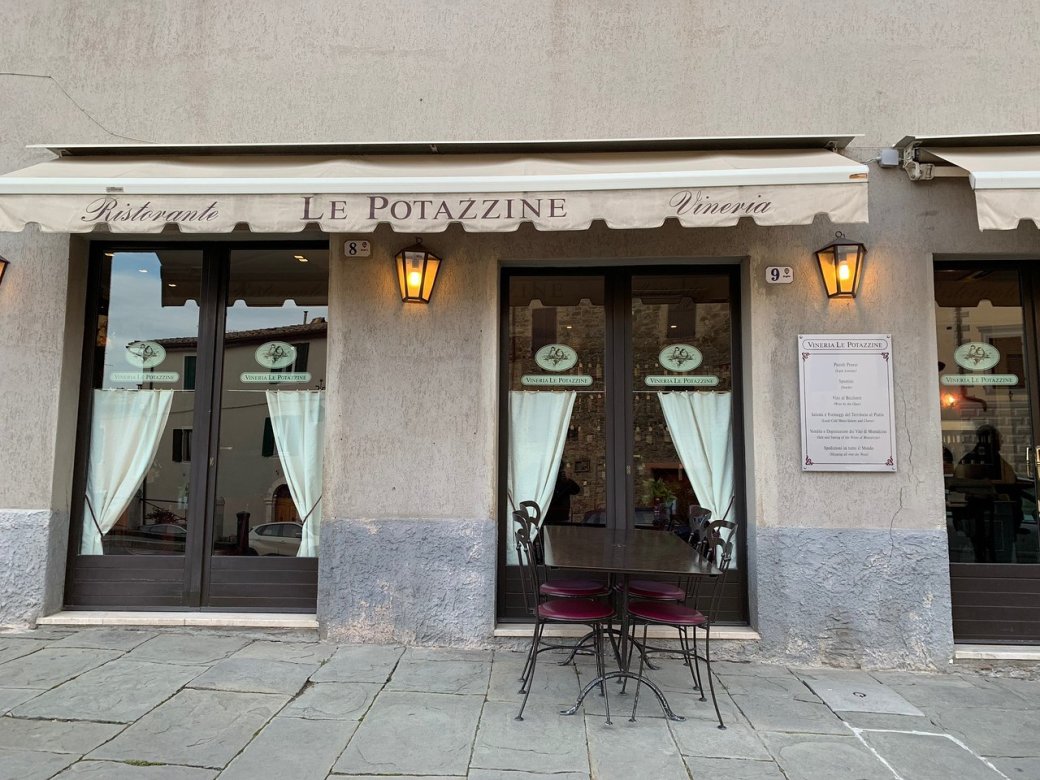 Vineria Le Potazzine
Vineria Le PotazzineBoccon Divino
Via Cafaggiolo, 10
ph. +39 055 8311279
Spatial view from the terrace of a family-run restaurant that convinces on two fronts: that of tradition, with a peposo and a steak of value, and that of moderately creative.
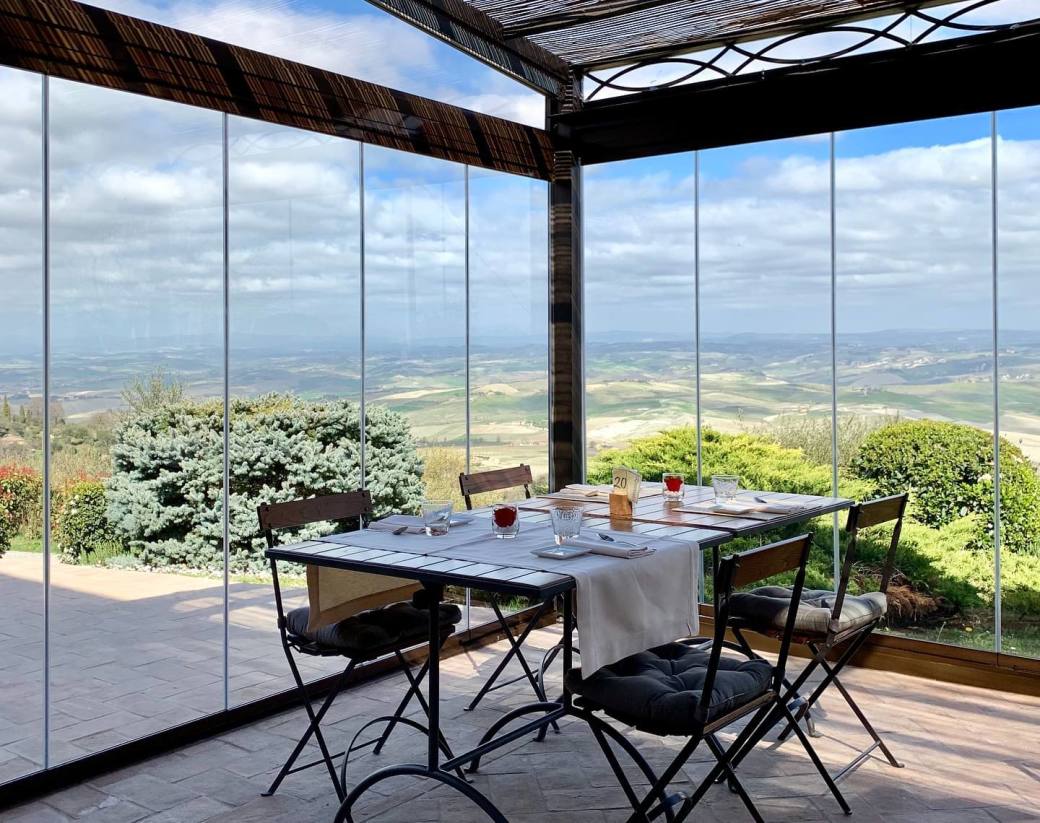 Boccon Divino
Boccon DivinoOsteria La Canonica - Rosewood Castiglion del Bosco
Castiglion del Bosco
ph. +39 0577 1913001
In the splendid estate of Massimo and Chiara Ferragamo (one of Italy's most beautiful wineresorts with a spa and golf course), the Osteria La Canonica offers a fresh menu, with dishes that smell of flowers and spices, such as lavender that becomes a sauce to be enjoyed. There is also pizza with ham and figs baked in the new wood-fired oven. Many of the products used in the kitchen come from the home garden, tended by the young chef Matteo Temperini, an emerging outsider you will hear more and more about. This year for the first time the Osteria is also open in autumn and for the Christmas holidays. Expect views as far as the eye can see of vineyards and the land.
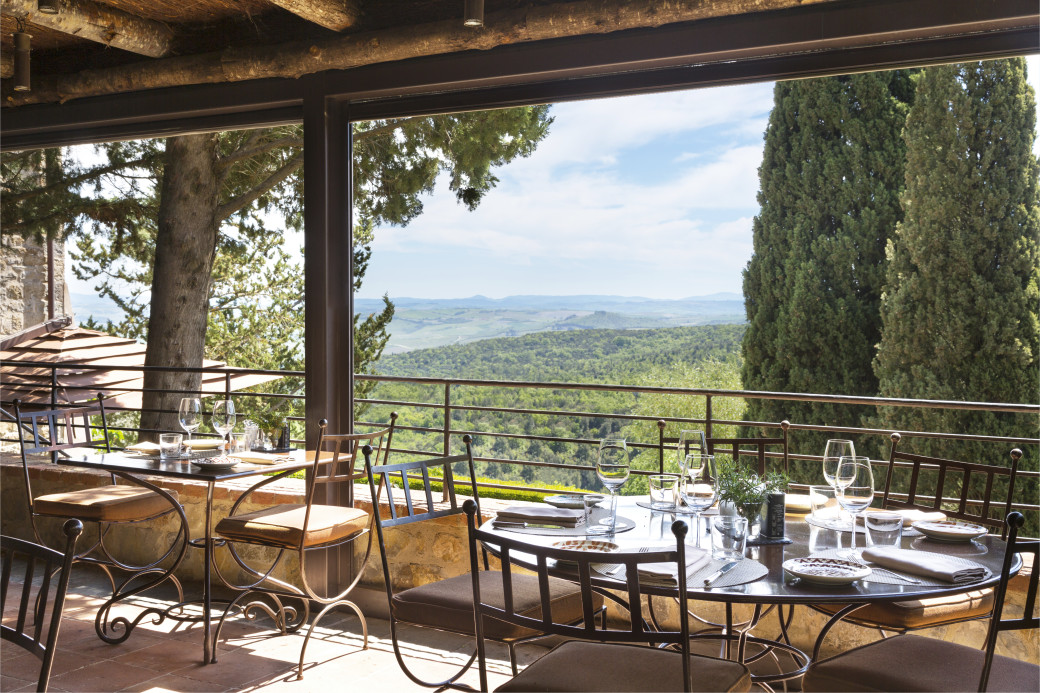 Osteria la Canonica
Osteria la CanonicaTaverna dei Barbi
Localita Podernovi, 170
ph. +39 0577 841111
Medieval furnishings, tapestries, curtains and low lighting: a place of great class and carefully prepared cuisine, from starters to desserts. In season, game and venison dishes are always recommended.
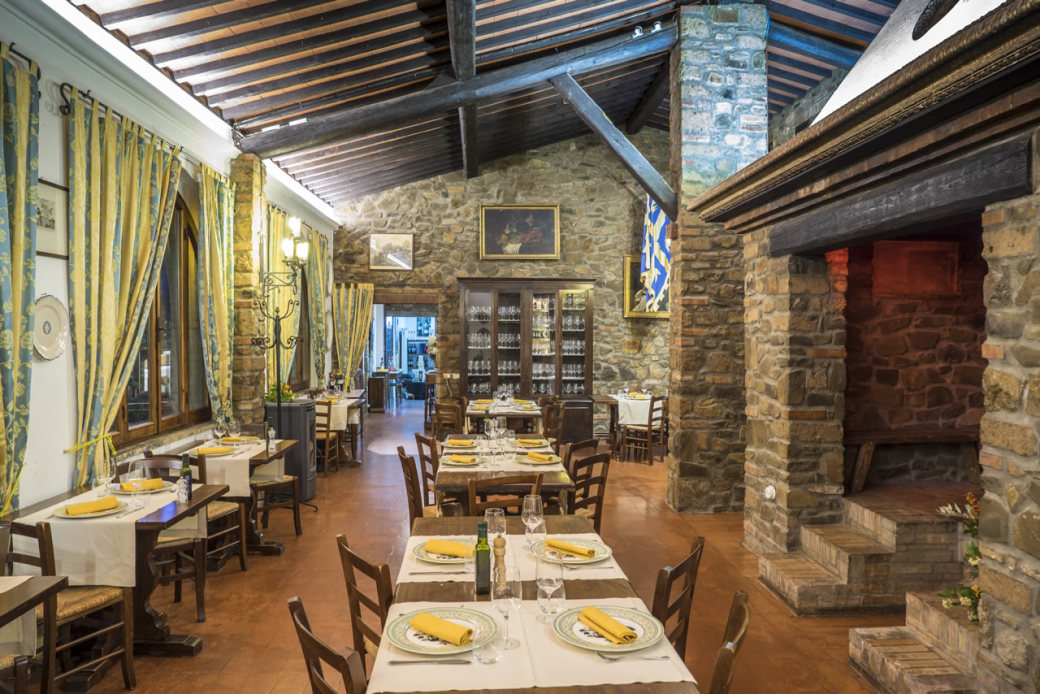 Taverna dei Barbi
Taverna dei BarbiDa Roberto al barrino di Montisi
Via Umberto I, 3
ph. +39 0577 845159
An authentic host, who gives his name to the restaurant and juggles between the dining room and the kitchen. Great products - such as cheese and vegetables - and simple cooking. A different experience.
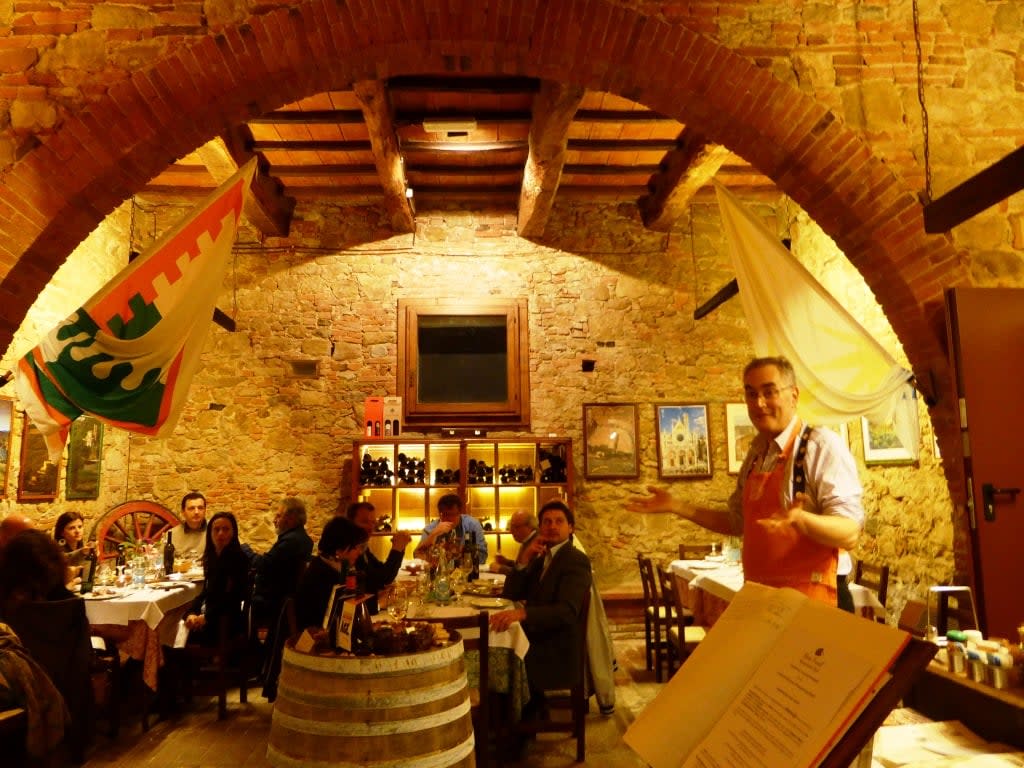 Da roberto in Montisi
Da roberto in MontisiTrattoria Il Pozzo
Piazza Castello
ph. +39 0577 844015
Set among the stones in the historic centre of Sant'Angelo in Colle, this restaurant has existed since 1968. Everything is handmade, from tortelli to pici and desserts. The pici all'aglione and onion soup are an excellent prelude to the show of barbecued meats.
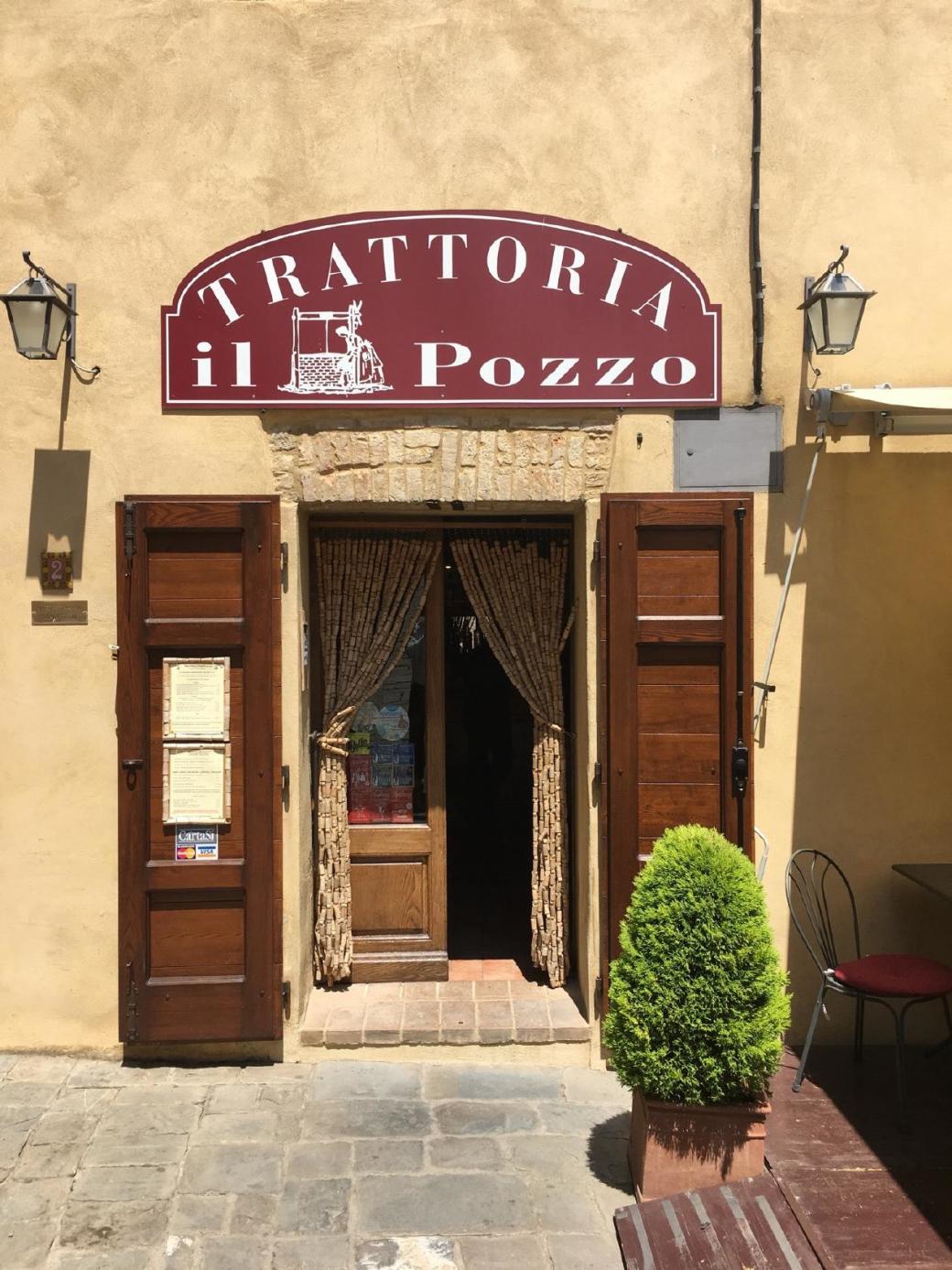 Trattoria Il Pozzo
Trattoria Il Pozzo
Trattoria Il Leccio
Costa Castellare
ph. +39 0577 844175
The interior is beautiful, medieval walls, candlelight, the scent of embers and a fireplace. Prosciutto and figs to start, continue with a ribollita and then you can lose yourself in the meat menu, they have certified Chianina IGP. In summer, it is possible to eat outdoors in the main square of Sant'Angelo in Colle.
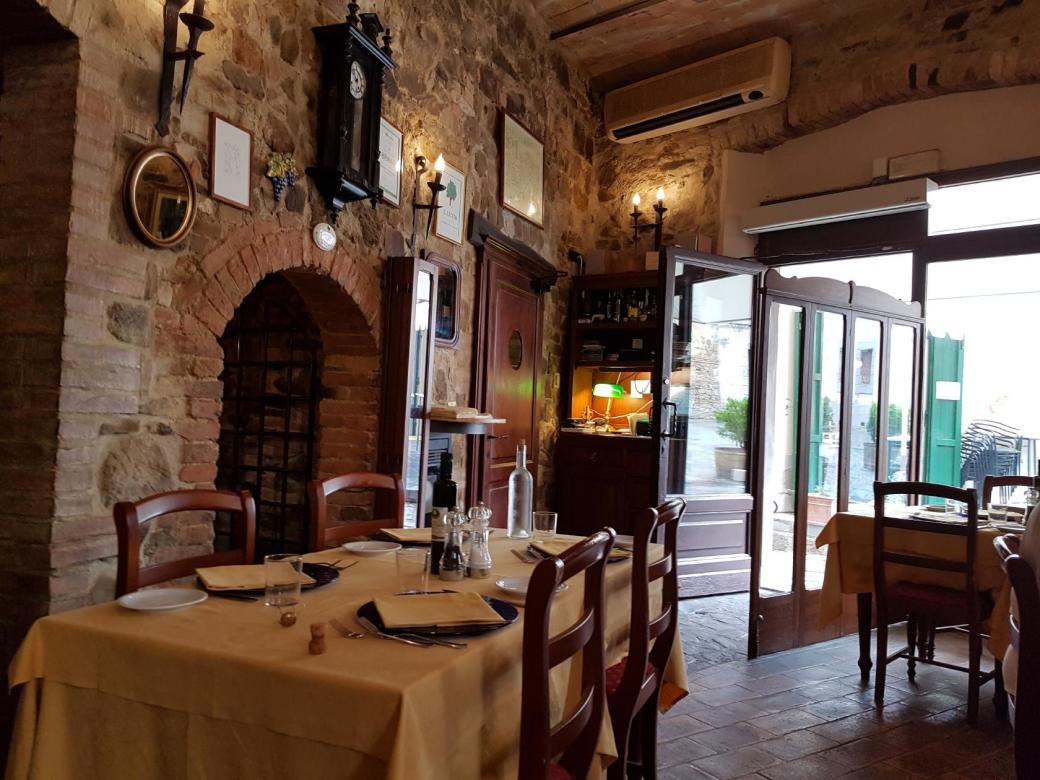 Trattoria Il Leccio
Trattoria Il LeccioWHERE TO SLEEP IN MONTALCINO:
Rosewood Castiglion del Bosco
Castiglion del Bosco
ph. +39 0577 1913001
An entire medieval hamlet transformed into a luxury hotel with a village equipped with small craft shops, gourmet restaurants, a golf course and a wine cellar with the private cellars of the guests of excellence, who keep their bottles stored, as if in a vault, for tasting there. Expanded with 19 luxury suites.
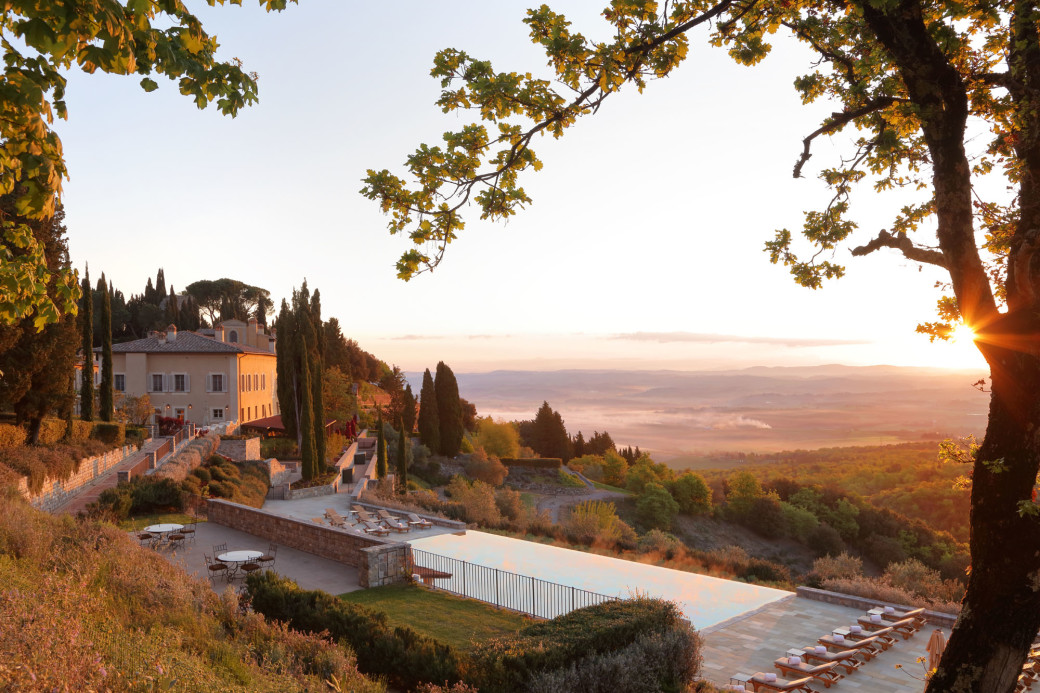 Rosewood Castiglion del Bosco
Rosewood Castiglion del BoscoCastello Banfi Il Borgo
Castello di Poggio alle Mura
ph. +39 0577 877700
Set amidst vineyards and woods, it offers a refined environment where you can relax and discover engaging multi-sensory experiences between two restaurants, the wine shop, the glass museum and the unique landscapes of the Sienese countryside.
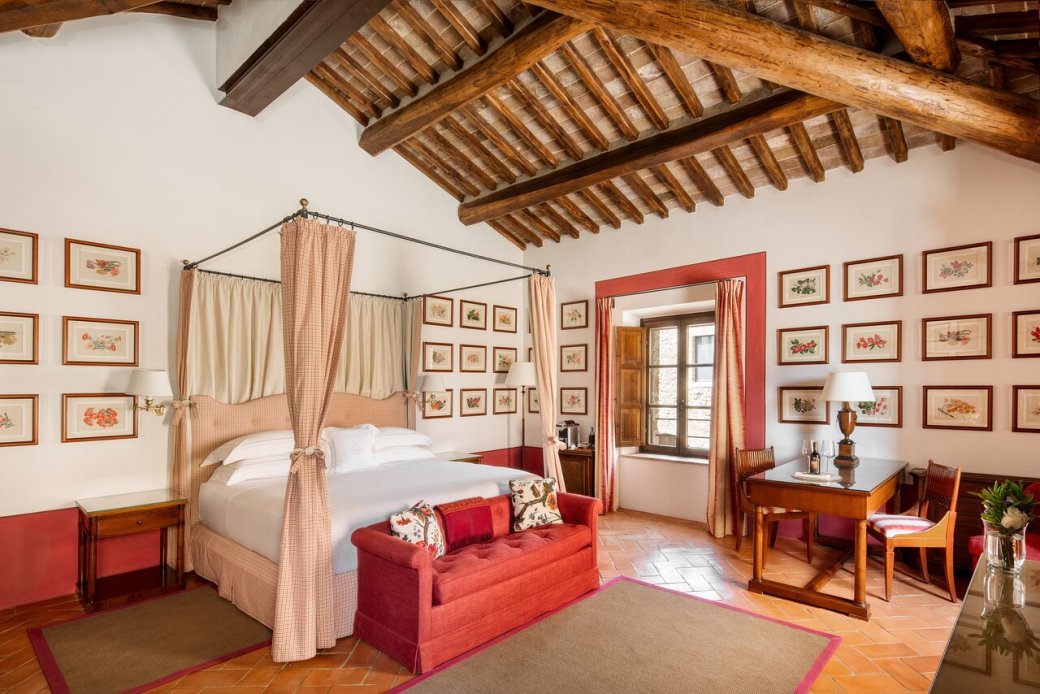 Castello Banfi Il Borgo
Castello Banfi Il BorgoCasanova di Neri Relais
Poderuccio
ph. +39 392 9441837
An old farmhouse and barn on the hilltop overlooking the winery. 10 meticulously and authentically restored suites and rooms in a perfect fusion of ancient and modern, luxury and comfort.
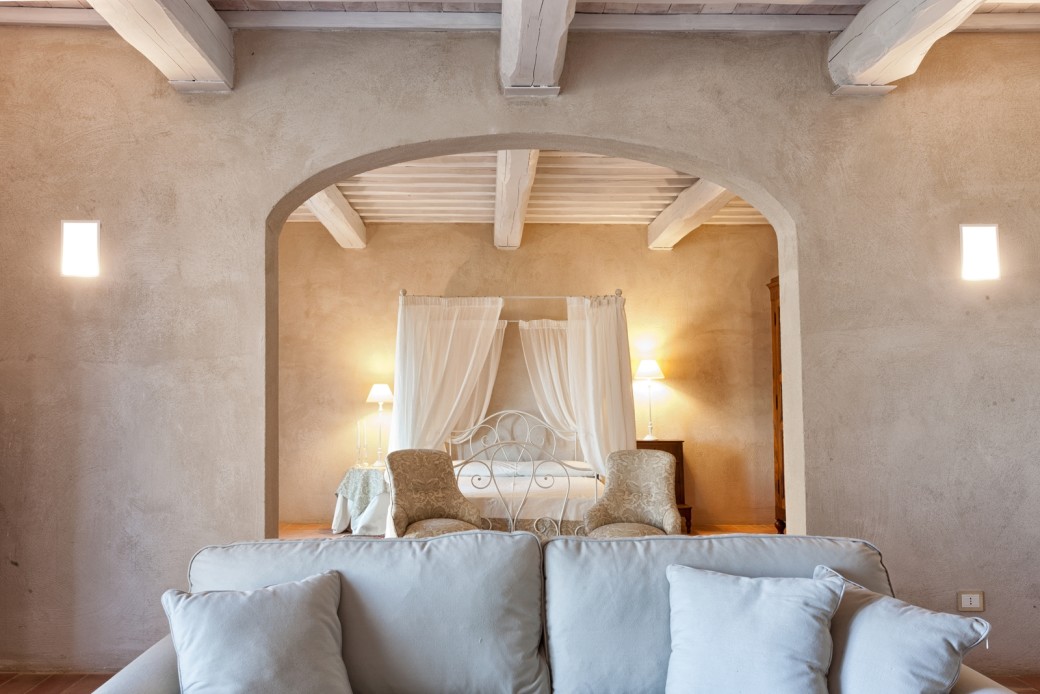 Canova di Neri Relais
Canova di Neri RelaisAlbergo Il Giglio
Via Soccorso Saloni, 5
ph. +39 0577 848167
Housed in an ancient palace built close to the castle walls of the town of Brunello, right at the point where a dizzying view overlooks the Crete and Siena, it is a small, family-run hotel where passion and simplicity are the watchwords.
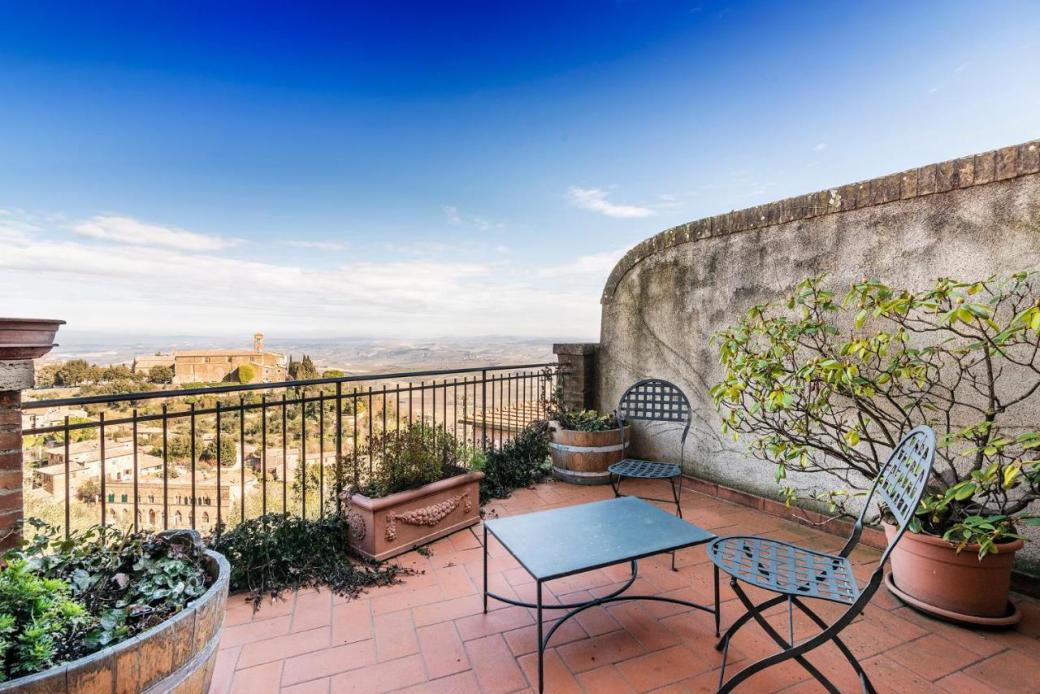 Albergo il Giglio
Albergo il GiglioCastello di Velona
Strada Provinciale della Badia di Sant'Antimo
ph. +39 0577 839002
It has become a super luxury hotel boasting three magnificent restaurants (Dolce Vita, Brunello and Settimo Senso) and a bar with one of the most beautiful views in Tuscany. In addition, there is a natural spa and a panoramic thermal pool...not bad at all.
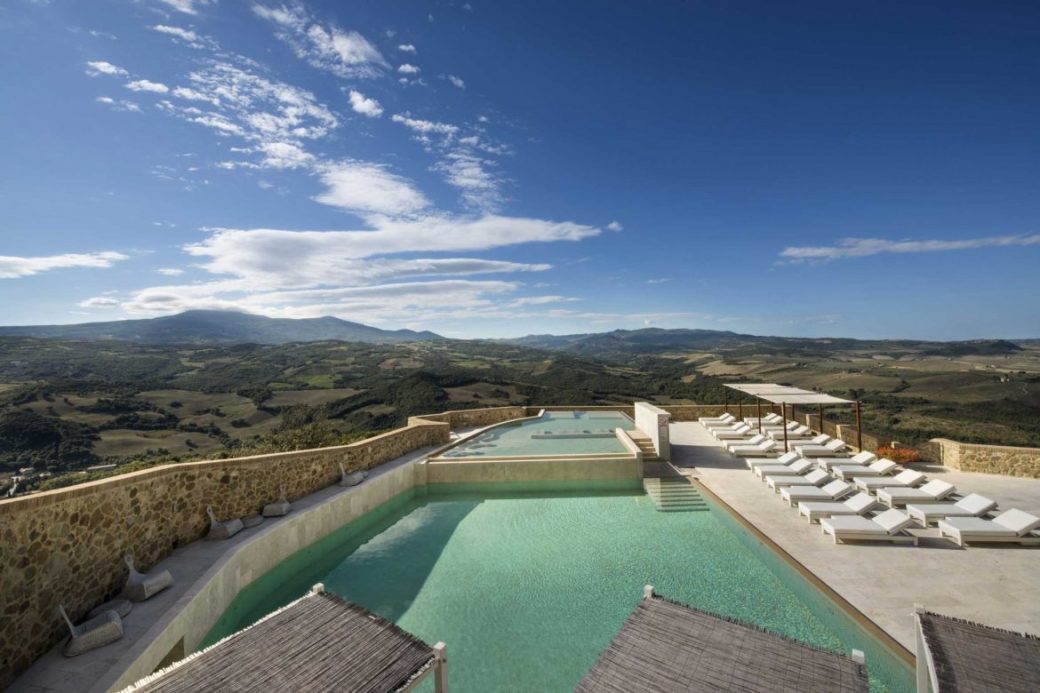 Castello di Velona
Castello di VelonaVilla Centinale
Str. di Cetinale, 9
ph. +39 0577 311147
One of the finest examples of the Roman Baroque style, by English MP Sir Antony Lambton. It has 13 bedrooms and can also be rented entirely for private events or holidays.
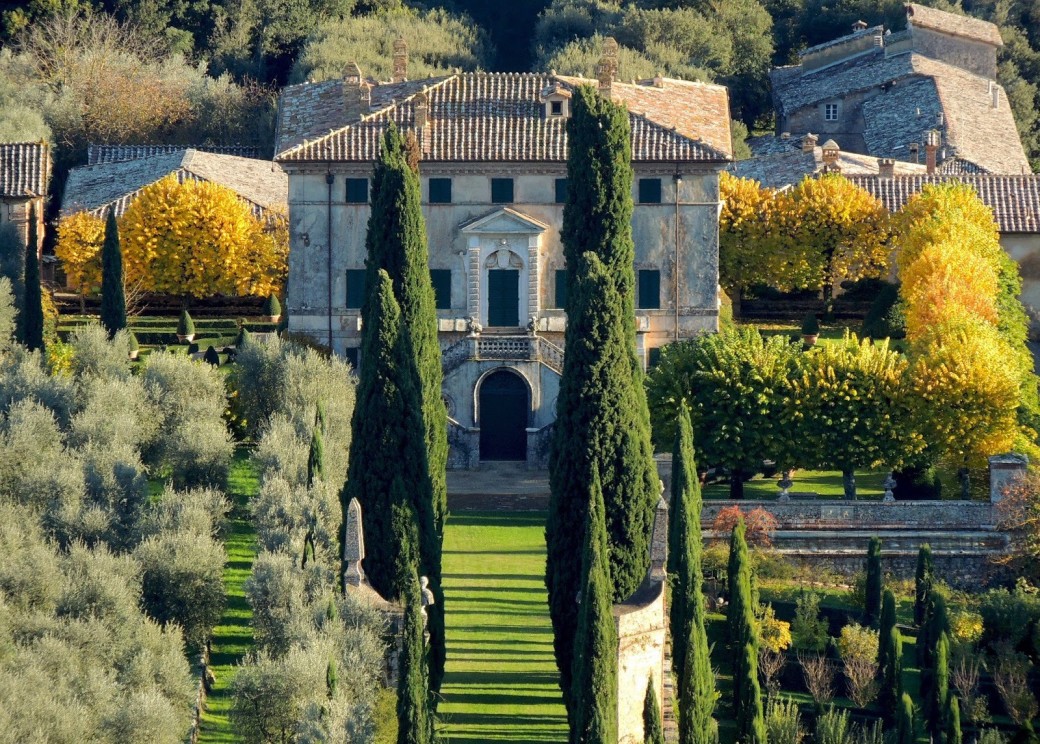 Villa Centinale
Villa CentinaleANNUAL APPOINTMENTS
Every year, in February, Benvenuto Brunello takes place at the Fortezza, the most important event dedicated to Brunello with the preview presentation of the new vintages ready to go on sale. For the occasion Montalcino is filled with buyers, journalists and important restaurateurs from all over the world. Another appointment not to be missed is the Eroica Montalcino, the cycle race on white roads that this year takes place on Sunday 28 May along the 209 km route of L'Eroica. The event takes place south of Siena between the Val d'Arbia, the Crete Senesi and the Val D'Orcia and transforms the centre of Montalcino into the stage for the festival, illuminated by lanterns made from the old jerseys of cyclists of yesteryear, and invested by the music, dances, costumes and bicycles of when cycling was heroic and popular. Also not to be missed are the Jazz & Wine festival in July and the Brunello previews in November.
WHAT TO BUY
You cannot leave Montalcino without tasting the excellent panpepato from the Lambardi bakery and Rossano Vinciarelli's pastries... impossible not to dive into his ricciarelli.
HOW TO REACH MONTALCINO FROM FLORENCE:
Take the A1 motorway in the direction of Rome. Exit at Firenze-Impruneta, take the Firenze-Siena superstrada. Get off at Siena Sud and take the SS2 (Cassia) towards Rome. Drive through the town of Monteroni d'Arbia, Buonconvento, turn right to get SP45 road and drive towards Montalcino.
The most convenient parking area is near the Forte, it is called Punto Sosta Camper or Parcheggio Albergheria and is free. A smaller parking area with a parking disc for 2 hours is Prato Spedale, fairly close to the centre (less than 10 minutes on foot).








